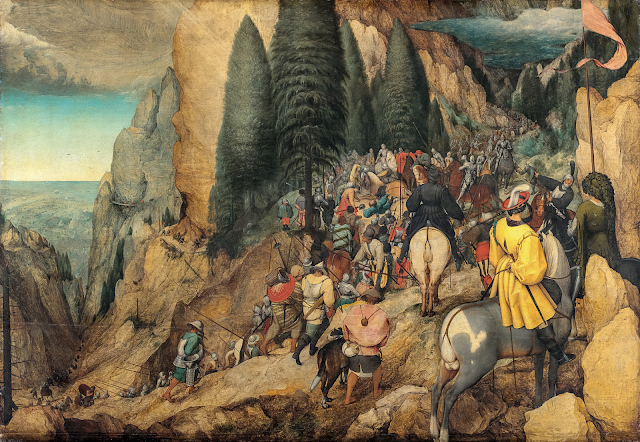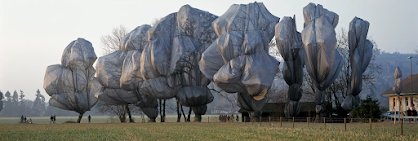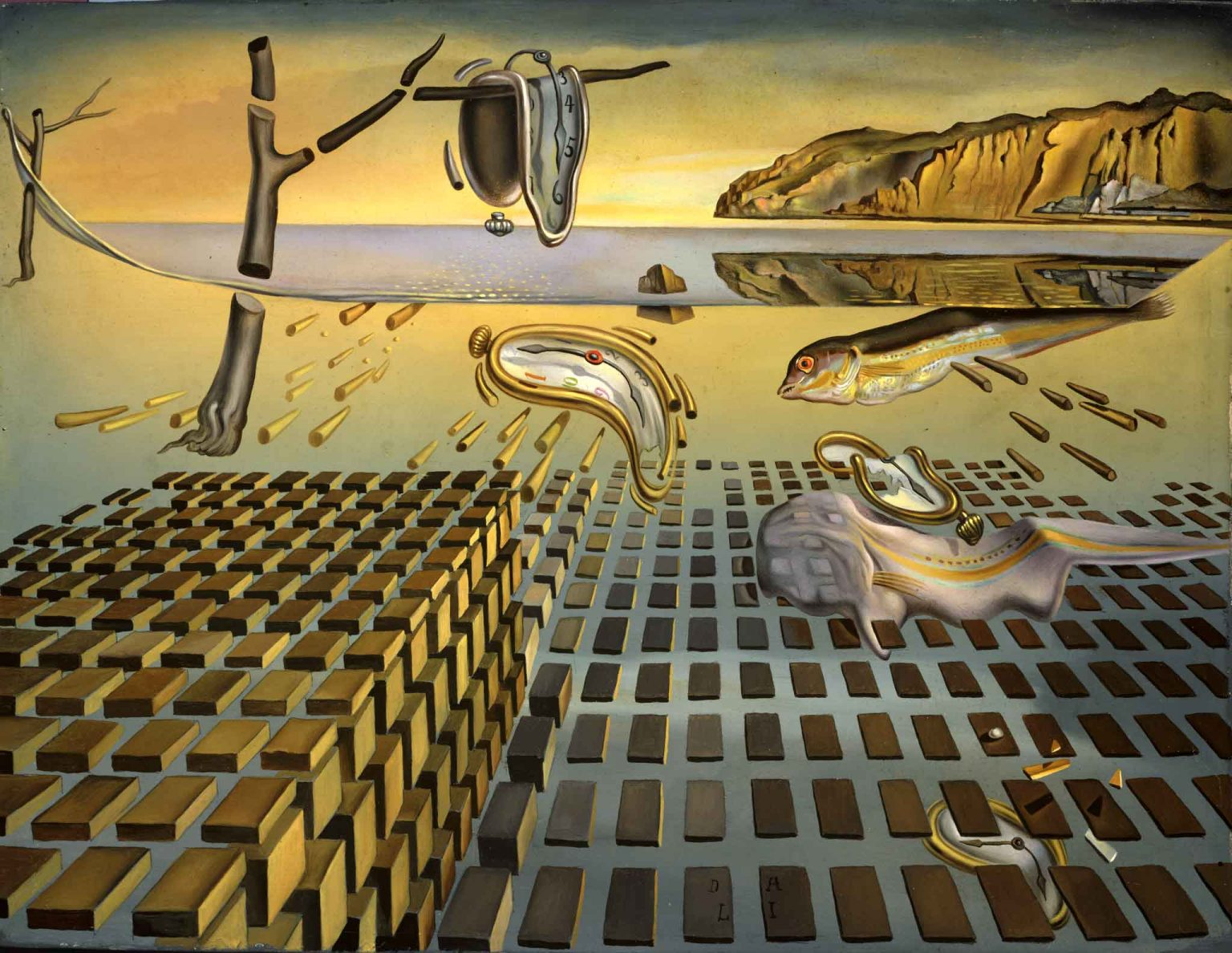Renaissance Post
The Conversion of Paul (1567)
About the Painting:
The Conversion of Paul is an oil painting from the Northern Renaissance by the Netherlandish painter Pieter Bruegel the Elder. Bruegel finished this painting in 1567 in Antwerp, Belgium. The scene depicts the Biblical account of God speaking to Saul (whose name was then changed to Paul) on the road to Damascus. Bruegel chose to portray Paul's army in the armor and clothing of the 16th century rather than in more historically accurate dress. Unlike other paintings depicting Paul's conversion, the main character of the painting is difficult to locate amidst the large crowd. He can be seen lying on his back in bright blue clothing in the center of the crowd.
Art Elements:
One element of art my eye is drawn to is lines. There are many diagonal lines dividing up the painting. The soldiers form a curving diagonal line from the bottom left to upper right portions of the painting. The trees and mountains are also formed from diagonal lines, which serve to further divide the painting into sections. Another very important diagonal line is the ray of light shining down on Paul from the heavens.
The colors in this painting are what catch my attention and lead my eye to focus on Paul. The bright yellow clothing on the man in the foreground is the first thing I notice. Then, my attention is drawn to the empty space in the upper-left. Next, I see the rear of a horse and the dark-clothed man riding it. my eyes then move to the dark cluster of trees in the middle. Finally, I notice the bright blue clothing of Paul. These five eye-catching locations create yet another diagonal line, moving the eye back and forth along its length until it comes to rest on Paul, the main focus of the painting.
Like many other Renaissance paintings, the contrast of light and dark tones creates depth and distance. It is used to create shadow and accentuate the sharp edges of the rocks. Bruegel's most important use of tone, in my opinion, is to create contrast in the sky in the upper corners of the painting. The left side of the painting uses a very light tone. the soft shades and open space create a sense of peace and distance. In contrast, the dark cloud and shadows in the upper right portion of the painting give a feeling of danger and confinement.
I enjoy the way this painting causes the eye to move from one object to another before you find Paul. However, it has a very crowded and busy feeling, so I don't think I would want to own a copy of it. Most art pieces depicting this story have Paul as the main focus of the painting, giving them a more personal feel, like you're experiencing it from Paul's perspective. His emotion is usually very evident in his facial expressions and body. In Bruegel's painting, Paul is very small and distant, making me feel more disconnected from what is happening.
The Conversion of Paul and the Protestant Reformation:
At the time of this painting's completion, the Protestant Reformation, as well as Counter-Reformation movements, were in full swing in Northern Europe. As was common in Renaissance art, this painting depicts a Biblical scene, however, the clothing and background in the painting are from Bruegel's own lifetime, suggesting this story's relevance to the Renaissance world. During Bruegel's lifetime, the area he lived in was predominantly Protestant (Bruegel Paintings, Bio, Ideas). This may have influenced him to paint works influenced by the Reformation.
Martin Luther, the founder of the Protestant Reformation, wrote his 95 Theses after studying the book of Romans from the Bible (Luther's Breakthrough in Romans). Romans was written by Paul. This makes Paul a crucial part of the Reformation. He was probably greatly admired by Reformers. It is possible that Paul's importance to the Reformation is why Bruegel decided to paint this work.
Additionally, the story of Paul's conversion parallels with the events surrounding the Reformation. Paul was antagonistic towards the Christians of his time before encountering God, as this painting depicts. After this event, Paul converted to Christianity. This is similar to how Martin Luther began as a Catholic monk. like Paul, he had a revelation that led him to change his beliefs and encourage others to do the same. Perhaps Bruegel was aware of this parallelism and was inspired to create art about it.
Works Cited:
“Bruegel Paintings, Bio, Ideas.” The Art Story, www.theartstory.org/artist/bruegel-the-elder-pieter/. Accessed 19 Feb. 2024.
“The Conversion of Paul.” Kunsthistorisches Museum, www.khm.at/en/object/328/. Accessed 19 Feb. 2024.
“Conversion of St. Paul, 1567 - Pieter Bruegel the Elder.” Wikiart, 24 Oct. 2016, www.wikiart.org/en/pieter-bruegel-the-elder/conversion-of-st-paul-1567#:~:text=%E2%80%98Conversion%20of%20St.%20Paul%E2%80%99%20was%20created%20in%201567,Pieter%20Bruegel%20the%20Elder%20in%20Northern%20Renaissance%20style.
Gurney, Tom. “Conversion of Paul.” The History of Art, TheHistoryOfArt.org, 14 Oct. 2023, www.thehistoryofart.org/pieter-bruegel/conversion-of-paul/.
“Luther’s Breakthrough in Romans.” Lutheran Reformation, 26 Oct. 2017, lutheranreformation.org/theology/luthers-breakthrough-romans/.
“Pieter Bruegel, the Elder.” Encyclopædia Britannica, Encyclopædia Britannica, inc., 9 Feb. 2024, www.britannica.com/biography/Pieter-Bruegel-the-Elder.
“The Story in Paintings: The Road to Damascus and the Conversion of Saint Paul.” The Eclectic Light Company, 1 Aug. 2016, eclecticlight.co/2016/08/06/the-story-in-paintings-the-road-to-damascus-and-the-conversion-of-saint-paul/.



Hello! I agree with your assessment on the busy aspect of this painting. I find that the vantage point from which one views this busy and seemingly chaotic event is sort of odd. I really would like to get closer and see what is happening. With that said, the scenery is pretty! I think your explanation on the use of tone in this work explains how the lovely setting is achieved.
ReplyDeleteThank you for the information on The Conversion of Paul and how it relates to the protestant reformation!
The bright yellow color of the rider in the bottom right corner is definitely eye catching. But I noticed the two horse butts facing the viewer immediately after. The tails struck me as odd, I’m assuming they’ve been docked or selectively bred. Otherwise, the painting is incredibly busy. We see so much detail everywhere that if I hadn’t read your explanation of the event being depicted, I would be completely unaware of what the focus of the painting was. The choice to use such a distant, off-center perspective makes me feel as if the artist does not put as much importance on this event, versus another artist that may choose to illustrate Paul closer up. The focus looks to be more in the landscape than anything else.
ReplyDeleteHello, the first thing that caught my eye was the trees, and the color of them i feel as though the scenory is more busy than the actual people walking down the hill.The way you mentioned color and the way that you can move to each object before finding paul. I enjoy busy paintings. Your explination of paul and The Reformation was very informative i would have never known it was a biblical scene if you had not mentioned that. I feel as though this brings more significance to the painting. Your explination to detail is very intriging with the way that colors are used.
ReplyDelete